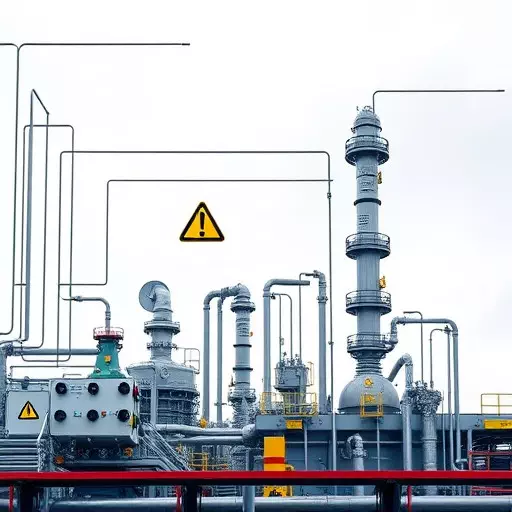Process incidents offer critical insights into potential hazards within industrial processes. Organizations can enhance process safety management through advanced hazard identification techniques, notably Process Hazard Analysis (PHA). This systematic method examines every step of a process to identify risks, evaluate consequences, and implement targeted risk mitigation strategies. By utilizing PHAs, companies gain actionable insights for enhancing process safety, optimizing procedures, and minimizing hazardous events. Past incidents provide valuable lessons for refining risk assessment practices, improving training, and implementing advanced monitoring systems. Engaging specialized process safety management consulting firms further enhances overall process safety through expert guidance in hazard identification, risk assessment, and best practice implementation.
“In the ever-evolving landscape of industrial processes, understanding and mitigating risks are paramount. This article explores vital lessons from process incidents, offering a comprehensive guide for enhancement and prevention. We delve into the intricacies of ‘Understanding Process Incidents’ to uncover potential hazards. Additionally, we highlight the significance of ‘Process Safety Management Consulting’ in incident avoidance and showcase advanced ‘Hazard Identification Techniques’.
A deep dive into ‘Process Hazard Analysis (PHA)’ reveals its method and benefits, while past incidents provide key takeaways for future process optimization.”
- Understanding Process Incidents: A Glimpse into Potential Hazards
- The Role of Process Safety Management Consulting in Incident Prevention
- Unveiling Hazard Identification Techniques: A Comprehensive Approach
- Delving into Process Hazard Analysis (PHA): Method and Benefits
- Key Lessons from Past Incidents for Enhancing Future Processes
- Strategies to Implement Effective Process Safety Measures Post-Incident
Understanding Process Incidents: A Glimpse into Potential Hazards

Process incidents, whether minor or major, offer critical insights into potential hazards lurking within industrial processes. These events serve as a stark reminder that even well-established operations can pose risks if not meticulously managed. By thoroughly understanding and analysing these incidents, organisations can gain valuable lessons in process safety management consulting.
Hazard identification techniques, such as Process Hazard Analysis (PHA), play a pivotal role in this process. PHA involves a systematic examination of processes to identify potential hazards, evaluate their consequences, and implement effective risk mitigation strategies. This proactive approach ensures that the intricacies of each step in a process are scrutinised, enabling organisations to forge ahead with enhanced safety protocols and improved operational efficiency.
The Role of Process Safety Management Consulting in Incident Prevention

Process Safety Management Consulting plays a pivotal role in preventing incidents within industrial processes. By employing robust hazard identification techniques and conducting thorough Process Hazard Analyses (PHAs), consulting firms can help organizations identify potential risks early on. PHAs involve a systematic evaluation of a process, considering all possible hazards and their consequences. This proactive approach allows for the implementation of effective risk mitigation strategies, ensuring that safety measures are tailored to each unique process.
Through these analyses, consultants provide valuable insights into existing processes, identifying areas that may be prone to accidents or failures. They offer recommendations for process improvements, equipment upgrades, and the adoption of best practices to enhance overall safety. By engaging with experienced process safety management consultants, industries can significantly reduce the likelihood of incidents, thereby fostering a safer working environment and minimizing potential environmental impact.
Unveiling Hazard Identification Techniques: A Comprehensive Approach

In the realm of process safety management consulting, uncovering potential hazards is a cornerstone of mitigating risks. Here, we explore various hazard identification techniques that serve as a comprehensive approach to enhancing process safety. One powerful tool is the Process Hazard Analysis (PHA), a systematic method that involves a multidisciplinary team to identify, evaluate, and mitigate hazards within industrial processes. By employing PHA, organizations can uncover hidden risks and implement effective controls.
This method includes detailed studies of process flowsheets, operational procedures, and historical incident data, enabling consultants to pinpoint potential failure modes. Through this comprehensive analysis, they can recommend tailored strategies, such as design modifications, safety systems upgrades, or enhanced training programs, to mitigate identified hazards. This proactive approach ensures that process-related incidents are not only prevented but also effectively managed if they occur.
Delving into Process Hazard Analysis (PHA): Method and Benefits

Delving into Process Hazard Analysis (PHA) involves a systematic method for identifying and mitigating potential hazards within industrial processes. As a key component of process safety management consulting, PHA leverages advanced hazard identification techniques to scrutinize every step of a process, from raw material input to final product output. This in-depth analysis not only uncovers hidden risks but also provides actionable insights for enhancing process safety.
By employing PHA, organizations benefit from a structured approach that promotes collaborative problem-solving among cross-functional teams. The process fosters a culture of thoroughness and proactive risk management, ensuring that potential incidents are identified and addressed before they escalate. Through PHA, companies can optimize their procedures, implement robust safety measures, and ultimately minimize the likelihood and impact of hazardous events, contributing to a safer working environment and improved operational efficiency.
Key Lessons from Past Incidents for Enhancing Future Processes

Past incidents serve as valuable learning opportunities for organizations to enhance their future processes and strengthen their process safety management consulting. By thoroughly investigating and analyzing these events, companies can uncover key lessons that offer profound insights into potential risks and vulnerabilities within their operations. These insights are instrumental in refining hazard identification techniques and fostering a more robust approach to process hazard analysis (PHA).
Through meticulous examination of past incidents, organizations gain a deeper understanding of the interplay between human factors, technical aspects, and environmental conditions that contribute to hazardous situations. This knowledge enables them to implement proactive measures, such as improved safety protocols, enhanced training programs, and advanced monitoring systems. By integrating these lessons into their ongoing process improvement initiatives, companies can mitigate risks more effectively, thereby ensuring safer operations and a reduced likelihood of future incidents.
Strategies to Implement Effective Process Safety Measures Post-Incident

Post-incident, organizations should implement robust strategies to enhance process safety. A comprehensive approach involves integrating multiple techniques and practices. One key step is conducting a thorough Process Hazard Analysis (PHA) to identify and assess potential hazards within the process. This analysis provides insights into the root causes of incidents and allows for the development of effective mitigation strategies.
Additionally, engaging specialized process safety management consulting firms can significantly contribute to enhancing overall process safety. These experts bring valuable knowledge and experience in hazard identification techniques, risk assessment, and implementation of best practices. By adopting these measures, organizations can proactively manage risks, ensuring a safer operational environment.


